10 Essential Methods for Effective User Experience Research

10 Essential Methods for Effective User Experience Research
Overview
The article discusses essential methods for effective user experience research, focusing on key techniques such as:
- User interviews
- Surveys
- Usability testing
- A/B testing
Each of these methods serves a vital role in enhancing our understanding of user behaviors and preferences. By employing these strategies, organizations can significantly improve product design and increase user satisfaction. Statistics indicate that effective UX practices yield high returns on investment, underscoring the importance of these methods.
How can these techniques be integrated into your research processes to maximize outcomes?
Introduction
User experience research has emerged as a vital cornerstone in the design and development of products that resonate with users. By employing a variety of essential methods, researchers can uncover valuable insights that drive innovation and enhance user satisfaction. However, with an ever-evolving landscape of techniques, how can organizations effectively navigate this complexity to optimize their research strategies? This article explores ten pivotal methods that not only streamline user experience research but also empower designers to create solutions that genuinely meet user needs and expectations.
Initial Data Offering: Streamline Your User Experience Research with Quality Datasets
Initial Data Offering (IDO) serves as a vital resource for acquiring high-quality datasets that significantly enhance research on interactions. By leveraging datasets centered on consumer behavior and market trends, researchers can uncover essential insights into individual preferences and challenges. This fosters informed decision-making, leading to improved interactions across diverse platforms and products.
The impact of high-quality datasets on design for individuals is profound. For instance, a well-organized dataset can illuminate pain points, enabling designers to create solutions that resonate with their audience. Industry leaders emphasize that utilizing consumer behavior data is crucial for refining user experience research strategies. A seamless interaction is not just a luxury; it is a necessity, as 88% of visitors are less likely to return to a site after a negative experience. Furthermore, investing in usability enhancements can yield substantial returns, with each dollar spent on UX potentially generating up to $100 in revenue.
Incorporating high-quality datasets into user experience research not only enhances usability but also fosters trust and engagement. As organizations increasingly recognize the significance of data-driven insights, platforms like IDO play a crucial role in bridging the gap between data availability and actionable improvements for individuals.
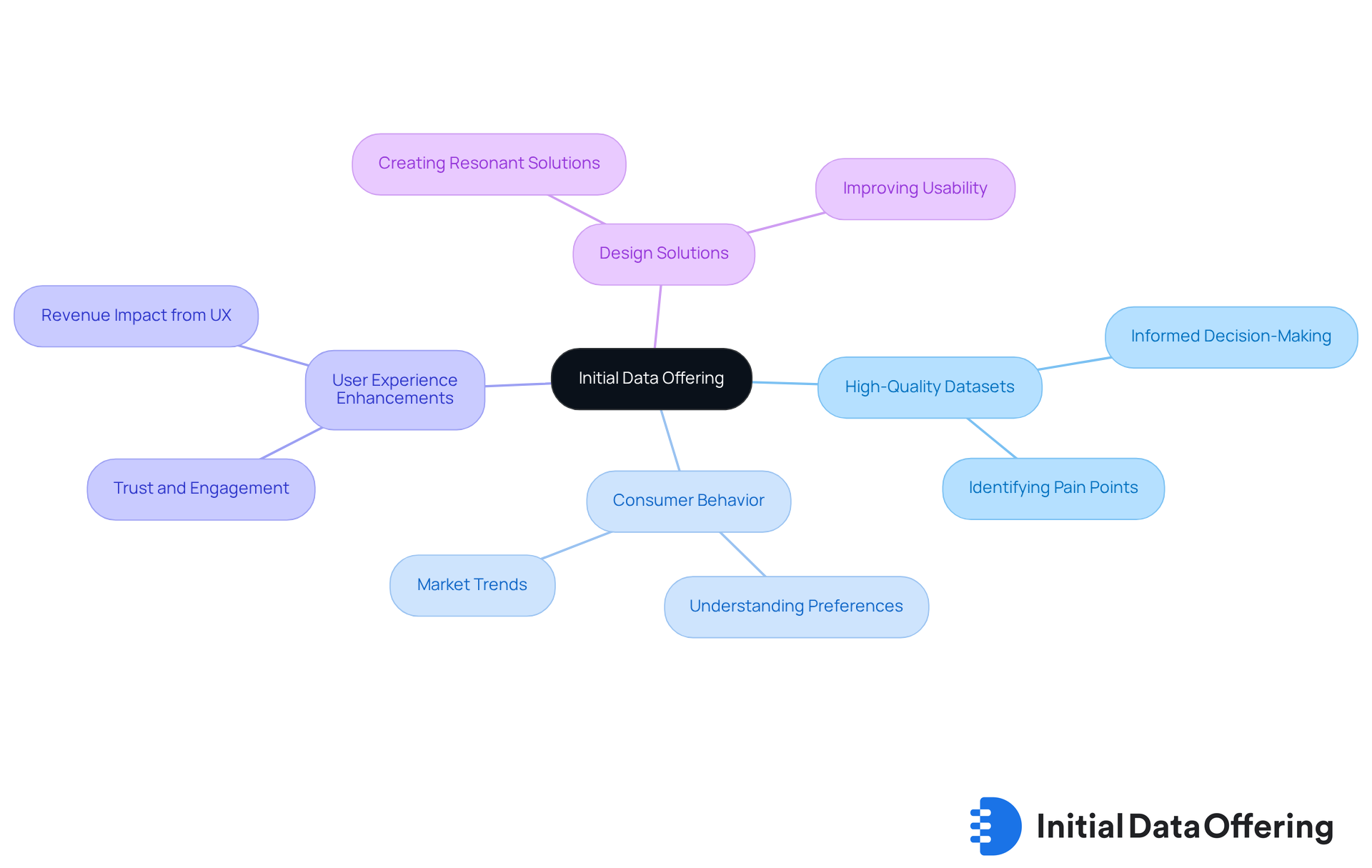
User Interviews: Gather In-Depth Insights from Your Target Audience
Interviews with participants are an essential resource for user experience research, enabling researchers to engage directly with their intended audience. This approach promotes a deep comprehension of needs and preferences by utilizing user experience research. By employing open-ended questions, user experience research can extract insights that quantitative data often overlooks, providing a qualitative method that is particularly effective for exploring intricate behaviors and motivations. This allows for a more nuanced perspective on user experience research in experience design.
Current trends indicate that 90% of researchers have enhanced their abilities through experimentation with various tools. This highlights the . Optimal methods for conducting effective participant interviews in user experience research involve:
- Preparing clear, relevant questions
- Establishing a comfortable setting for attendees
Notably, 83% of respondents qualitatively measure the impact of their work, underscoring the significance of user experience research in gathering rich, qualitative insights.
As Bill Gates aptly observed, 'Your most unhappy customers are your greatest source of learning.' This emphasizes how user experience research, particularly through customer interviews, can uncover essential feedback that promotes product enhancement. Additionally, it is crucial for interviewers to approach sessions with an attitude of openness, as highlighted by Ann Blandford, to foster a trusting environment essential for effective user experience research. Researchers conducting user experience research should also be vigilant about potential pitfalls, such as leading questions or overwhelming participants with information, to ensure the integrity of the insights gathered.
By prioritizing open-ended inquiries and preparing a set of questions in advance, user experience research can uncover deeper insights that guide development choices and improve satisfaction among individuals. How might these insights influence your approach to research? Consider the implications of these findings in your own work.
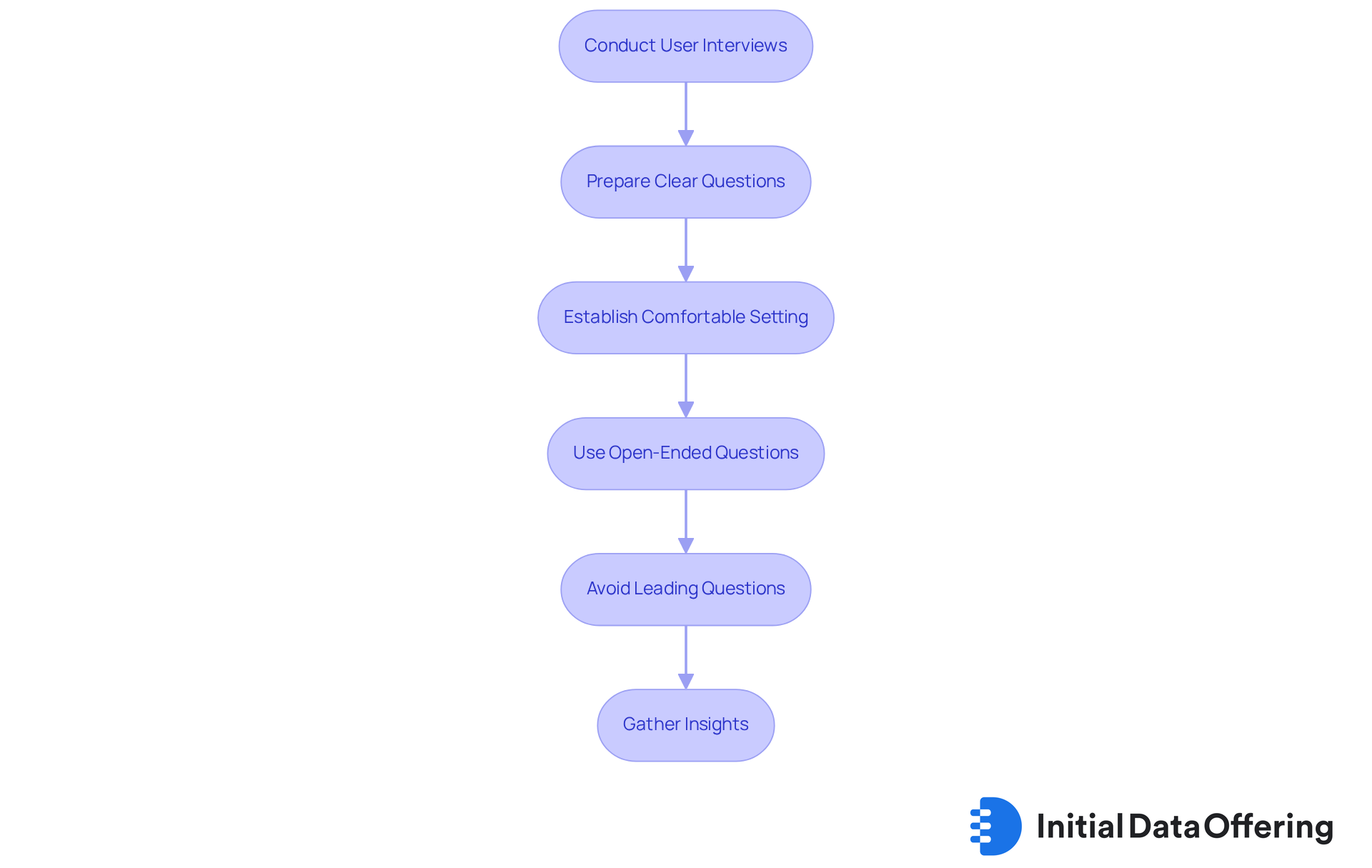
Surveys: Collect Quantitative Data to Inform Design Decisions
Surveys are a vital instrument for collecting quantitative data that directly informs design decisions. They allow researchers to reach a diverse audience, extracting regarding participant preferences, satisfaction levels, and the importance of various features. Analyzing these survey results reveals trends and patterns crucial for guiding product development and enhancing user experience research. As W. Edwards Deming aptly stated, 'Without data, you're just another person with an opinion,' underscoring the significance of data-driven insights in forming effective strategies.
In 2025, the role of surveys in informing design decisions continues to evolve, with methodologies becoming increasingly sophisticated. Effective survey techniques, such as clear and relatable questions, are essential for gathering actionable participant data. Oscar Wilde's perspective that surveys should be relatable and understandable to respondents reinforces this point. By utilizing surveys, designers can ensure that their creations resonate with individuals, ultimately leading to improved satisfaction and engagement.
Ongoing user experience research, as highlighted by Teresa Torres, is essential for adapting to evolving needs and preferences. How can your organization leverage surveys to enhance user experience research? By integrating feedback mechanisms, you can adapt your design strategies to meet the changing demands of your audience.
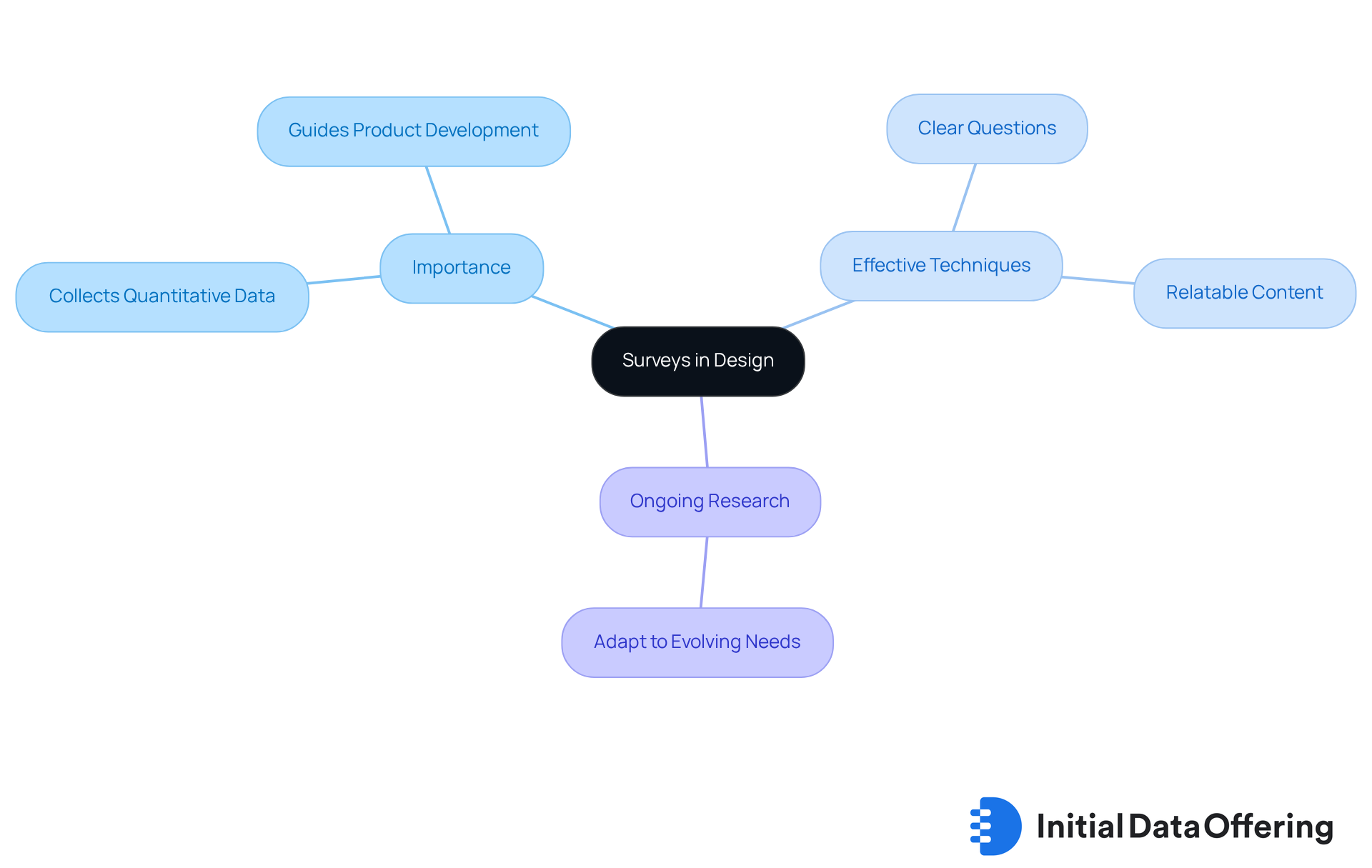
Usability Testing: Validate Product Functionality with Real Users
User experience research is an essential technique that involves observing actual individuals as they interact with a product or prototype. This approach yields direct feedback on product functionality, which is essential for user experience research to pinpoint usability issues and identify areas for improvement. For instance, a case study revealed that a Brazilian real estate company increased form submissions by 57% after enhancing the usability of their search box. This demonstrates the tangible benefits of effective usability testing across various industries.
User experience research involves analyzing participant behavior during testing sessions to gather both quantitative and qualitative data that informs design choices. Significantly, five participants can reveal up to 85% of usability issues when testing continuously. This statistic underscores the effectiveness of small sample sizes in detecting critical problems, highlighting how even a limited number of participants can provide significant insights. Thus, usability testing emerges as a cost-effective strategy for improving product functionality. Experts emphasize that user experience research, which involves observing actual individuals, provides insights that may not be evident through alternative approaches. As Pratyusha Guha from VWO states, "If an individual is facing an issue, it's our issue," underscoring the importance of addressing customer challenges to enhance overall experience.
Conducting usability testing involves defining clear tasks for participants and ensuring they understand the objectives. For instance, during facilitated usability evaluations, it is essential to refrain from clarifying concepts to prevent bias, allowing participants to engage organically with the product. This technique not only but also fosters a consumer-focused approach that aligns with client expectations.
Integrating feedback from users into the design process is crucial for user experience research to develop products that resonate with consumers. A well-designed website can evoke positive emotions and set a favorable tone, while poor usability can lead to immediate abandonment. Therefore, investing in usability testing is not merely a best practice; it is a strategic necessity for businesses seeking to enhance client satisfaction through user experience research and drive conversions.
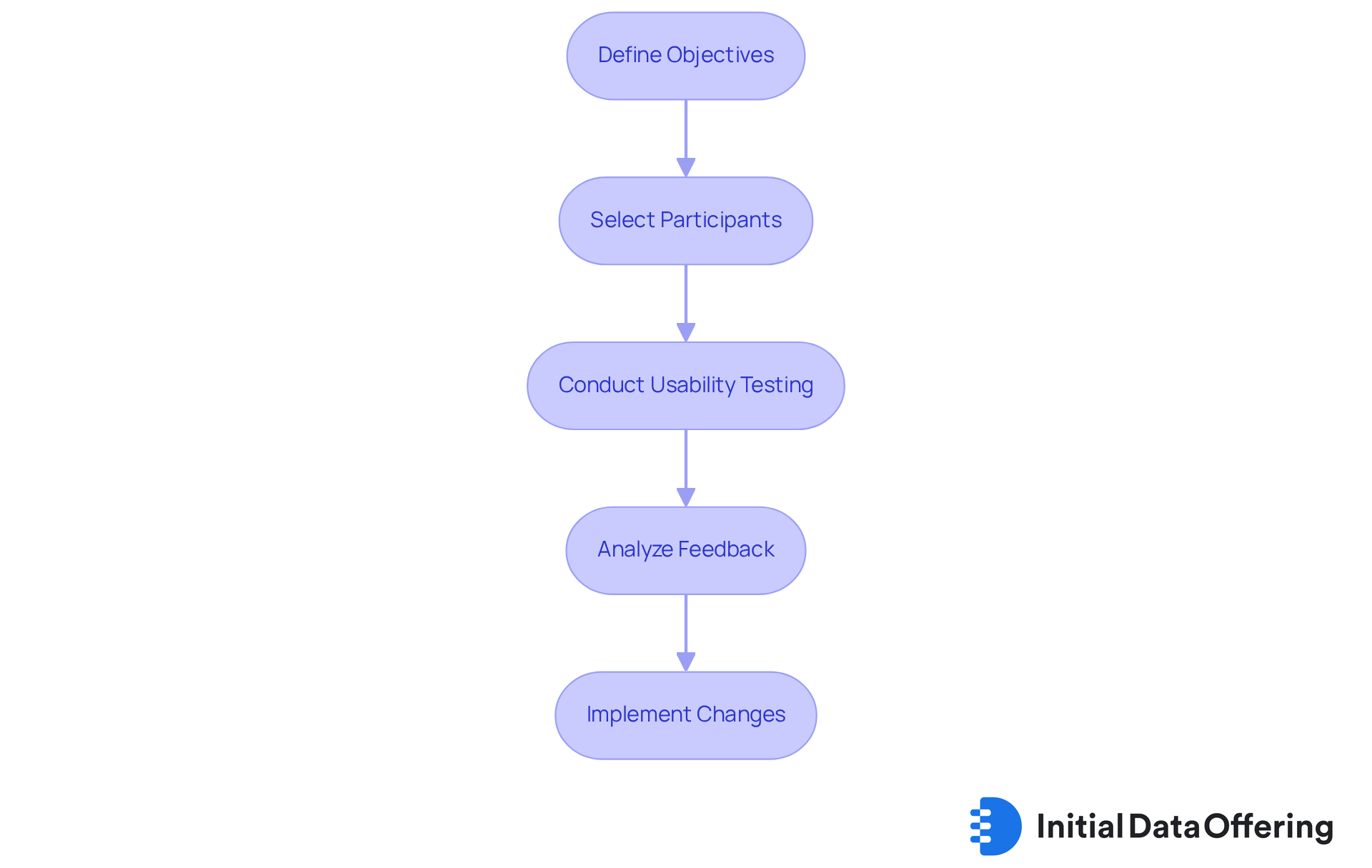
A/B Testing: Optimize User Experience Through Controlled Experiments
A/B testing is a powerful method for enhancing user experience by comparing two versions of a webpage or product feature to identify which performs better. This process involves randomly assigning individuals to different versions, allowing researchers to gather valuable data on interactions and preferences. Such controlled experiments are essential for making informed choices, as they provide concrete evidence of what resonates with users.
For instance, Hyundai's 'Mobility Adventure' campaign on Roblox aimed to engage young, tech-savvy consumers. By utilizing A/B testing, they refined their advertising strategy, leading to improved engagement with this demographic. By examining interactions, Hyundai was able to enhance display ads, ensuring they effectively captured the attention of potential clients.
Moreover, effective instances of A/B testing in product development illustrate its significant influence on audience engagement. A notable case involved an e-commerce site that changed the label of a call-to-action button from 'Purchase' to 'Buy Now.' This simple adjustment significantly increased conversion rates by enhancing clarity and interaction for users.
Digital marketers emphasize the importance of controlled experiments in influencing creative choices. As one specialist pointed out, "A/B tests can gradually enhance the experience of a product while successfully achieving business objectives." This method not only aids in understanding user behavior but also guides future development iterations.
However, it's crucial to note that only one in seven A/B tests is successful, underscoring the necessity of a strong, data-based hypothesis. Common mistakes in A/B testing, such as stopping tests too early or focusing on a single metric, can lead to misleading conclusions and should be avoided.
Recent success stories further illustrate the effectiveness of A/B testing in UX design. For example, integrating A/B testing in the development of a gaming campaign led to a record-breaking click-through rate, showcasing how strategic experimentation can drive significant results. By leveraging A/B testing, organizations can continuously refine their offerings, ensuring they meet client needs and preferences effectively. To maximize the benefits of A/B testing, always before starting your tests.
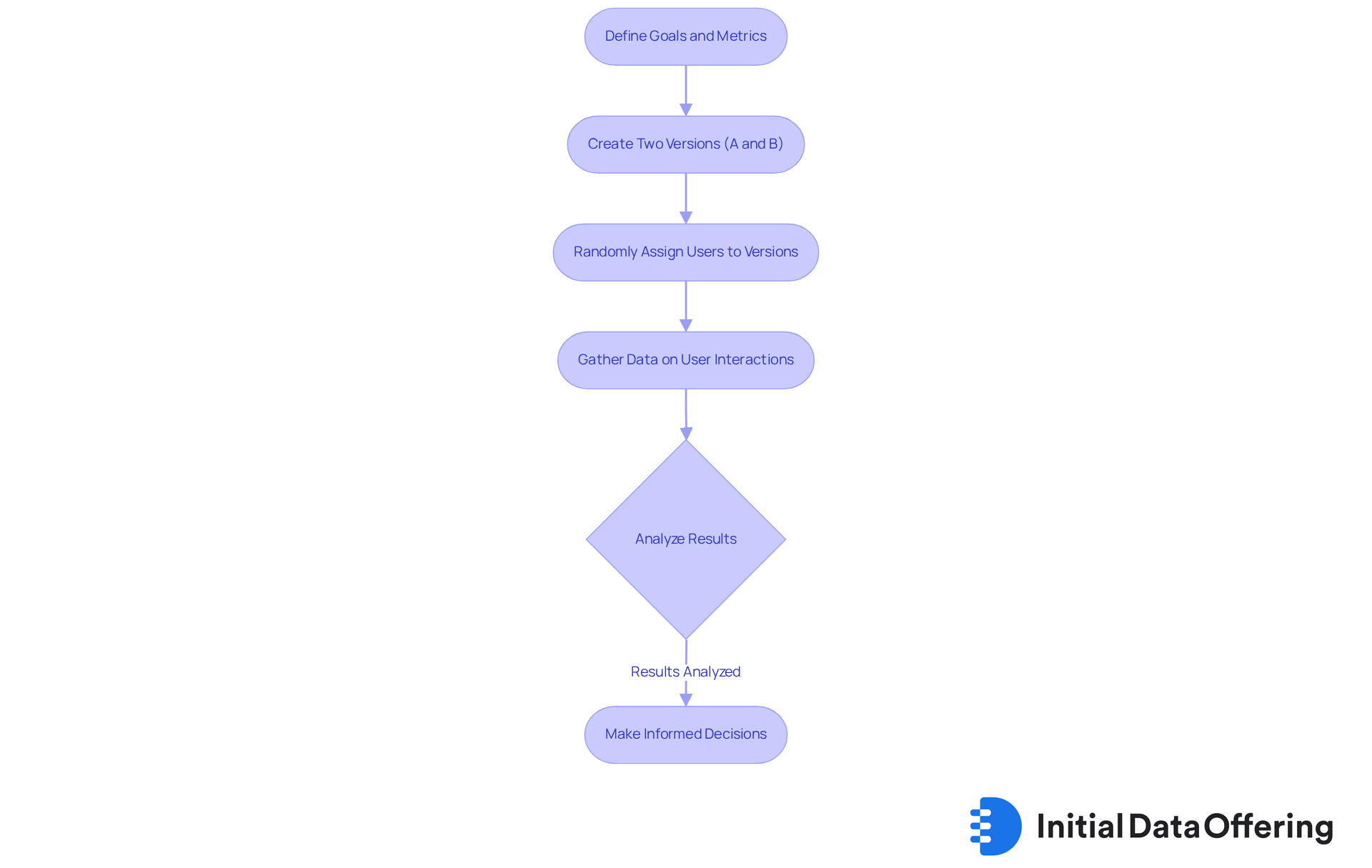
Contextual Inquiry: Understand User Behavior in Real-World Settings
User experience research utilizes as a method that involves observing and interviewing individuals in their natural environments as they interact with a product. This approach provides several key features for user experience research:
- It allows researchers to gather real-time data.
- It helps understand user behavior.
- It identifies challenges that may not surface in traditional research settings.
The advantages of this method include deeper insights into workflows and user interactions gained through user experience research, which can lead to more effective solutions tailored to user needs. Ultimately, by comprehending the context in which individuals operate, user experience research allows researchers to develop products that better satisfy user requirements.
How might this approach enhance your understanding of user needs in your own projects?
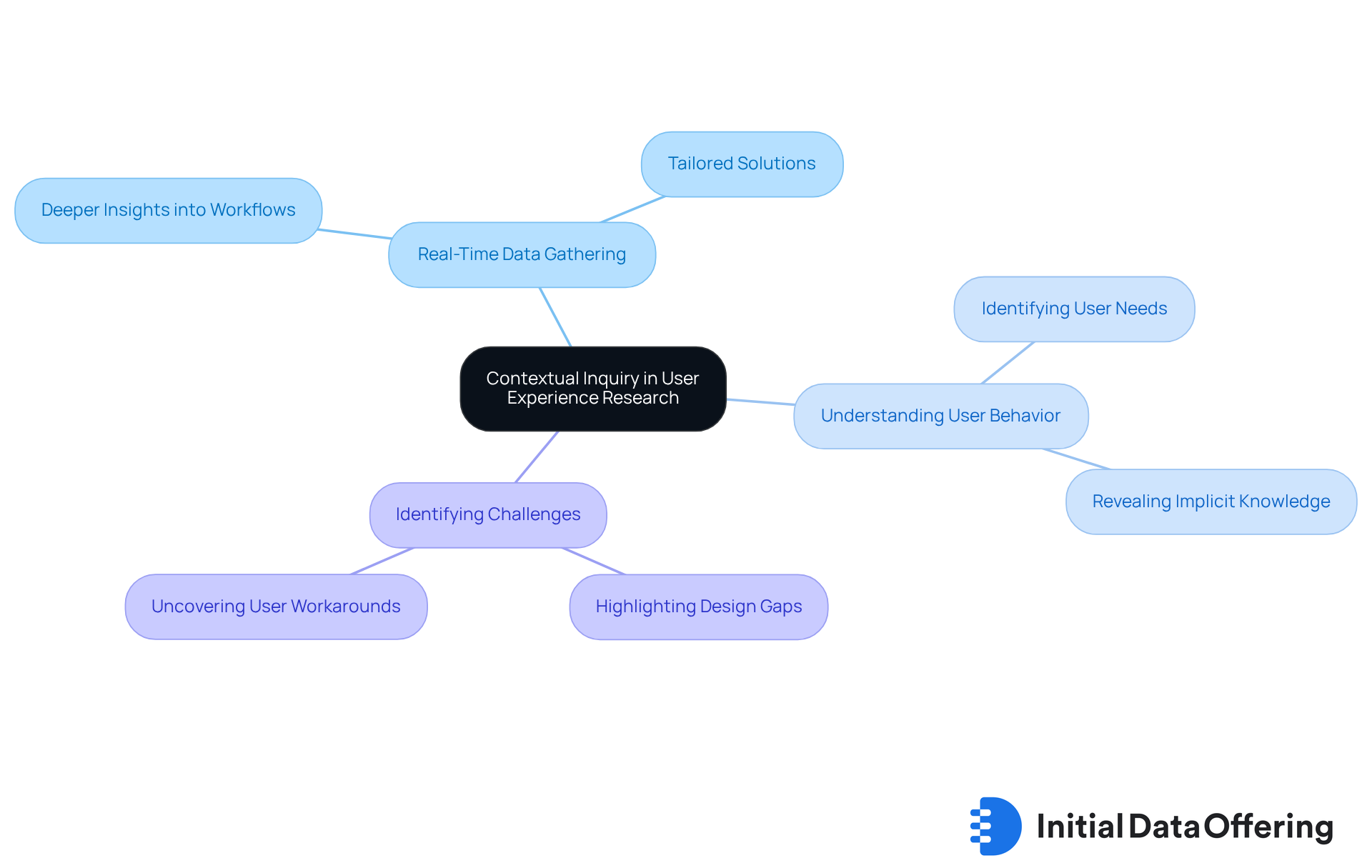
Card Sorting: Enhance Information Architecture Based on User Preferences
Card sorting is an essential method for understanding how individuals categorize information. In this process, participants receive cards representing various content items and are tasked with grouping them according to their perceptions. This approach not only reveals user preferences but also informs user experience research to develop intuitive information architecture and navigation systems that meet user expectations, thereby improving the overall experience.
As Frank Chimero points out, effective UX design centers on the individual, suggesting that any design that neglects the needs of users is likely to fail. Recent studies show that well-executed card sorting can significantly improve navigation for users. For instance, when Scott Belsky advocates for simplicity in interaction, he underscores the importance of clear navigation, achievable through properly conducted card sorting sessions. By examining the outcomes of these sessions, researchers can uncover patterns that contribute to a more user-friendly interface.
Best practices for conducting card sorting sessions include:
- Ensuring a diverse participant pool to capture a broad spectrum of perspectives
- Providing clear instructions to reduce confusion
As Billy Gregory emphasizes, designing for everyone, including individuals with disabilities, is vital for creating inclusive experiences. Successful instances of card sorting have demonstrated its ability to streamline user journeys by eliminating unnecessary elements, thus making navigation more intuitive.
UX designers stress the importance of to understand user preferences in organizing information. By focusing on user experience research and usability assessments, creators can refine their offerings based on real feedback, ultimately leading to products that resonate with their audience. Notably, design-oriented companies can outperform competitors by 228%, underscoring the significance of effective UX design and consumer research.
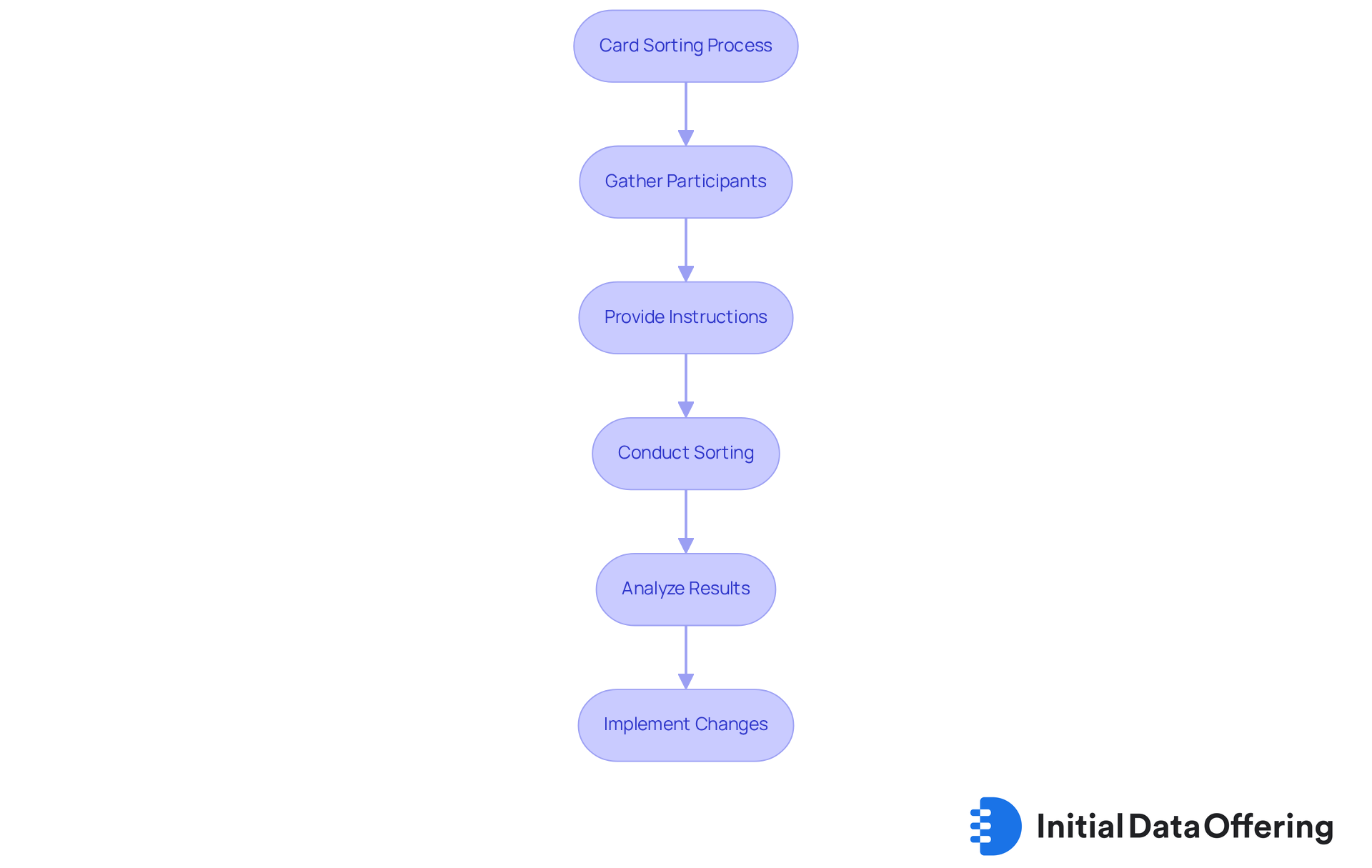
Diary Studies: Capture User Experiences Over Extended Periods
Diary studies require participants to document their experiences and interactions with a product over a specified timeframe. This practice yields valuable insights into consumer behavior and long-term engagement. By analyzing diary entries, researchers can identify trends and patterns that inform product enhancements. For example, a significant retailer experienced a 45% increase in customer purchases, generating an additional $15 million in revenue within the first month of implementing changes based on diary study findings. Similarly, a diary study conducted for a global streaming platform revealed challenges related to payment processes, leading to optimized solutions that significantly improved conversion rates.
Conducting effective diary studies is straightforward, utilizing accessible tools like Google Docs and WhatsApp, making them both cost-effective and efficient. The expense of a diary study is comparable to just two traditional interviews, underscoring its efficiency. Participants typically dedicate around 35-40 minutes each week to record their insights, providing a rich source of qualitative data. To , researchers should maintain regular communication with participants and select individuals whose behaviors align with the study’s objectives. As UX researcher Mariann Fülöp highlights, ongoing communication is vital for collecting high-quality data in diary studies.
Expert insights underscore the importance of diary studies in understanding motivations and emotional responses. These studies capture actual usage trends and decision-making processes, offering deeper insights into individual interactions over time. Furthermore, every dollar invested in UX yields an average return of $100, resulting in an impressive 9,900% ROI. This statistic emphasizes the critical need for investment in experience research, including diary studies. By following best practices—such as over-recruiting participants to mitigate potential dropouts and planning post-study interviews—researchers can uncover valuable insights that inform product development and enhance participant satisfaction.
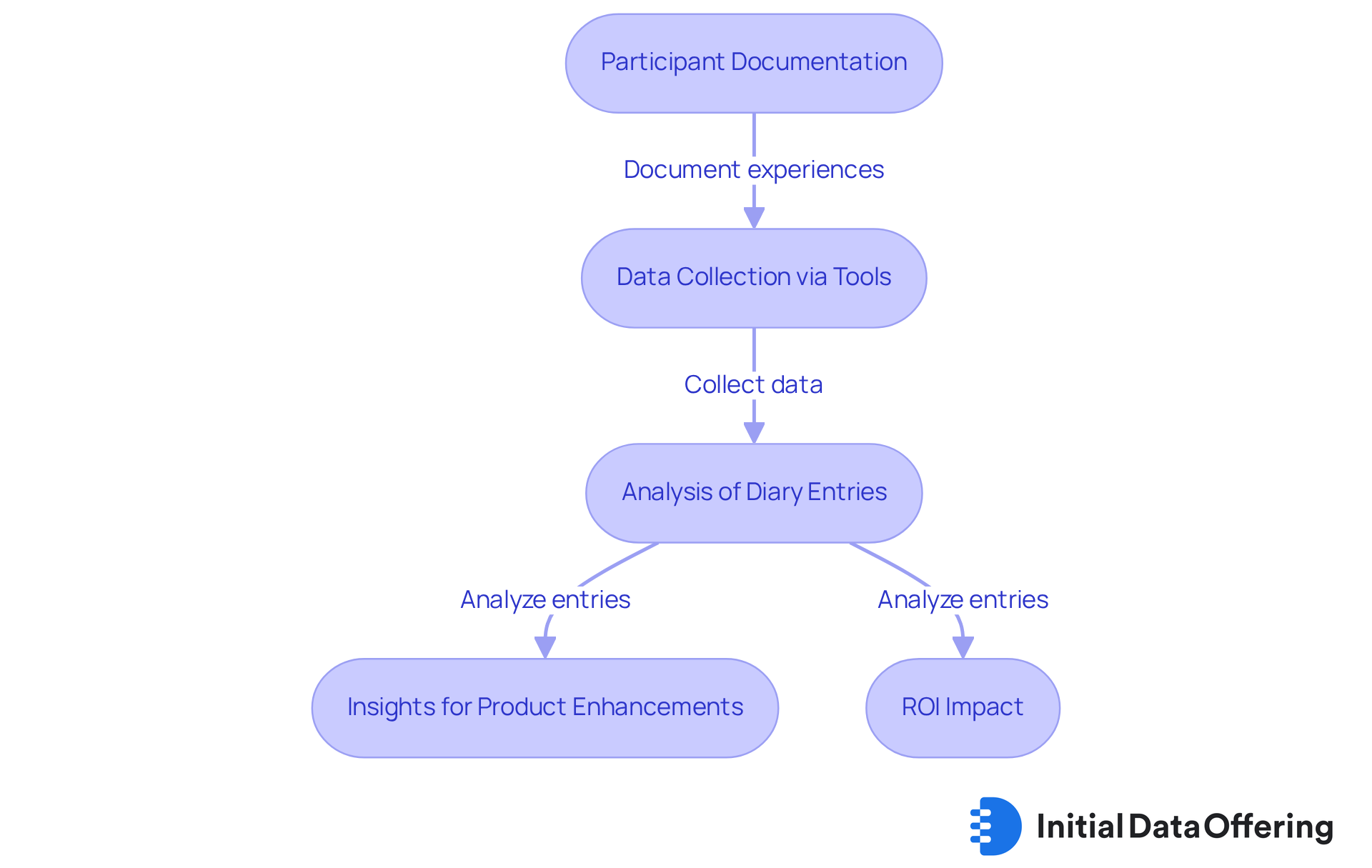
Heatmaps: Visualize User Engagement to Improve Design
Heatmaps serve as powerful visual tools that effectively illustrate user engagement across webpages and applications. By analyzing heatmap data, researchers can identify areas that garner the most attention while also highlighting elements that may be overlooked. For instance, a case study revealed that companies utilizing AI-driven heatmaps experienced a 25% increase in conversion rates within three months by optimizing page layouts based on anticipated visitor focus. Additionally, 85% of organizations employing advanced heatmap tools reported notable enhancements in user experience research, resulting in a 30% increase in engagement. This data is crucial for refining planning strategies, ensuring that key features are prominently displayed and easily accessible.
UX analysts emphasize the importance of leveraging heatmap data in user experience research to inform decision-making. As Andrew Chornyy states, "A heatmap is your fast UX scanner," pointing to its ability to swiftly identify areas for improvement. John Maeda further asserts, "The craft used to be the seasoning you'd sprinkle on for taste; now it's the flour you need at the start of the recipe," highlighting the fundamental role of craftsmanship in interaction design. By integrating heatmaps into the development process, teams can create more intuitive interactions that enhance engagement and drive conversions. Ultimately, the not only optimizes website layout but also fosters a deeper understanding of visitor behavior, paving the way for continuous improvement.
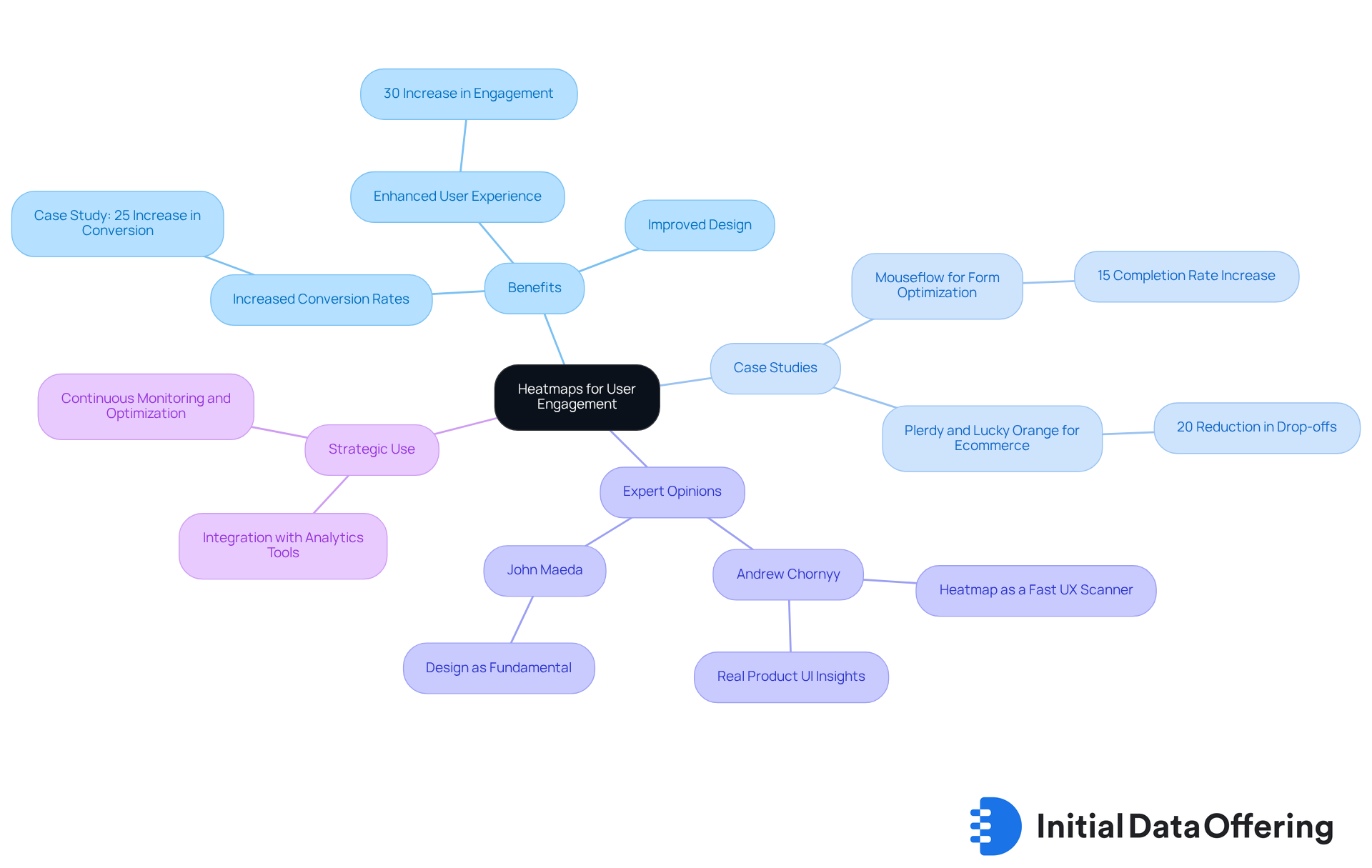
Analytics Tools: Leverage Data to Drive User Experience Improvements
Analytics tools serve a vital function in monitoring individual behavior and engagement metrics, offering invaluable insights that enhance user experience research. By leveraging data from these tools, researchers can identify emerging trends, evaluate the impact of changes, and target specific areas for improvement. For instance, research indicates that a well-designed interface can boost conversion rates by as much as 200%. This underscores the critical role of data in guiding design decisions. Additionally, companies prioritizing customer satisfaction report an average return of $100 for every dollar invested, showcasing the financial benefits of a data-driven approach. Furthermore, a mere 1-second delay in page loading can lead to a 7% decline in conversions, underscoring the importance of speed in user experience research. As Forrester states, "Every $1 spent on UX generates $100 for businesses on average," reinforcing the significance of analytics in enhancing engagement. To effectively harness these insights, user experience research should routinely analyze and implement iterative design changes, ensuring that products not only meet but exceed user expectations, thereby fostering loyalty and driving engagement.
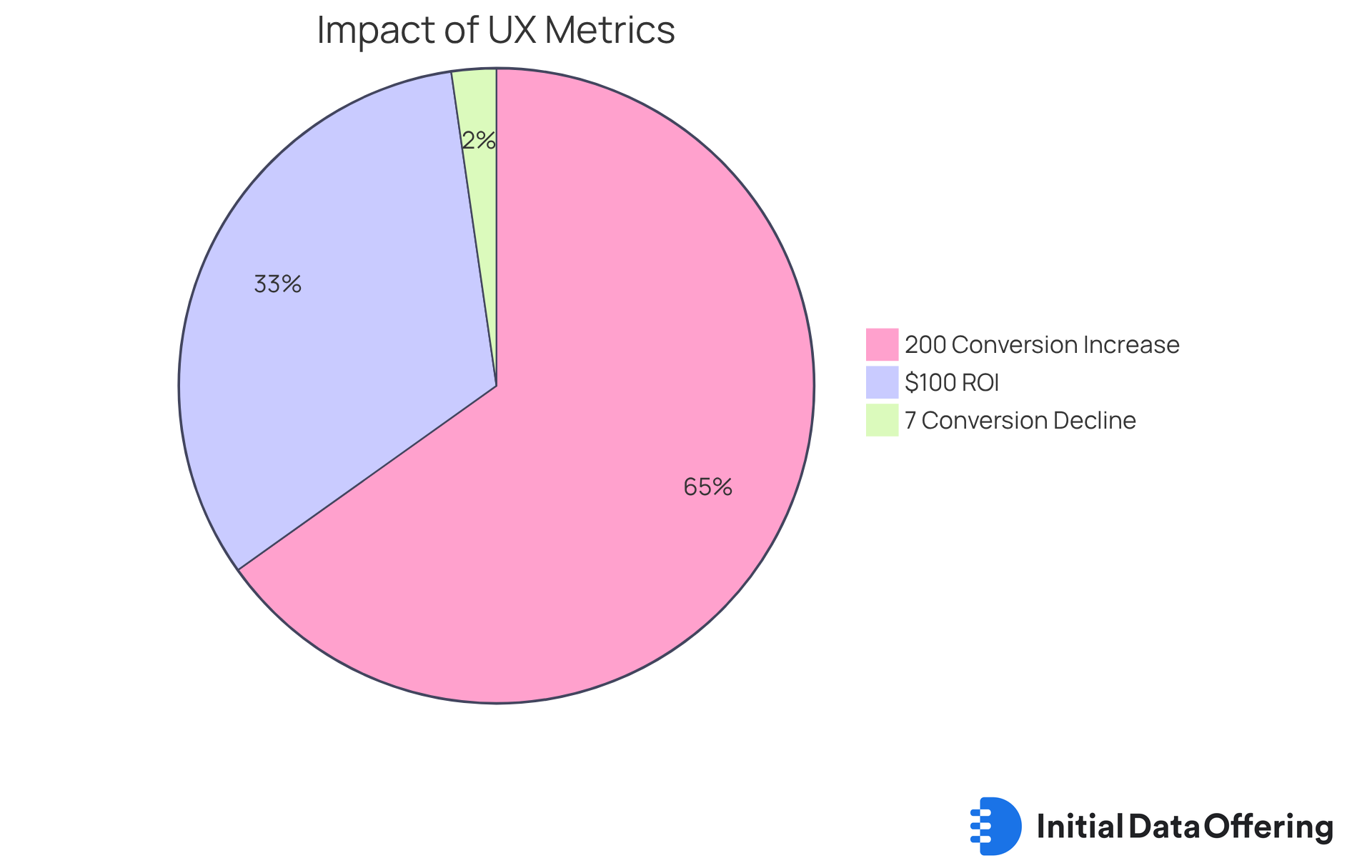
Conclusion
User experience research serves as a crucial element in the development of products and services that genuinely connect with users. By utilizing a diverse array of methods—from Initial Data Offerings to A/B testing—researchers can extract invaluable insights that inform design choices and elevate user satisfaction. Each technique, including user interviews, surveys, usability testing, and contextual inquiry, presents distinct advantages that enrich our understanding of user needs and behaviors.
This article underscores the significance of leveraging high-quality datasets, engaging directly with users through interviews, and implementing robust testing strategies to drive notable enhancements in user experience. The insights derived from these approaches not only aid in pinpointing pain points but also steer the creation of intuitive interfaces and engaging interactions, ultimately fostering user loyalty and contributing to business success.
As organizations increasingly prioritize user experience, embracing these fundamental research methods becomes imperative. By investing in effective user experience research techniques, companies can ensure they remain attuned to user needs, adapt to shifting preferences, and cultivate enduring relationships with their audience. The necessity of comprehending user behavior is paramount—adopting these strategies is not merely advantageous; it is essential for achieving sustained growth and innovation in today's competitive landscape.
Frequently Asked Questions
What is the Initial Data Offering (IDO) and its purpose?
The Initial Data Offering (IDO) is a resource for acquiring high-quality datasets that enhance research on interactions, particularly focusing on consumer behavior and market trends to uncover insights into individual preferences and challenges.
How do high-quality datasets impact user experience design?
High-quality datasets illuminate pain points, enabling designers to create solutions that resonate with their audience. They are crucial for refining user experience research strategies and improving interactions across platforms.
What are the consequences of negative user experiences according to the article?
According to the article, 88% of visitors are less likely to return to a site after a negative experience, highlighting the importance of seamless interactions.
What is the potential return on investment for usability enhancements?
The article states that every dollar spent on user experience (UX) can potentially generate up to $100 in revenue.
Why are user interviews important in user experience research?
User interviews allow researchers to engage directly with their target audience, promoting a deep understanding of needs and preferences that quantitative data may overlook.
What techniques can improve the effectiveness of participant interviews?
Effective participant interviews can be improved by preparing clear, relevant questions and establishing a comfortable setting for attendees.
What percentage of researchers qualitatively measure the impact of their work?
The article mentions that 83% of respondents qualitatively measure the impact of their work, emphasizing the significance of user experience research.
What should interviewers avoid to maintain the integrity of insights gathered?
Interviewers should avoid leading questions and overwhelming participants with information to ensure the integrity of the insights collected.
How do surveys contribute to user experience research?
Surveys are vital for collecting quantitative data that informs design decisions, allowing researchers to gather insights on participant preferences, satisfaction levels, and feature importance.
What is essential for gathering actionable data through surveys?
Effective survey techniques such as clear and relatable questions are essential for gathering actionable participant data.
How can organizations leverage surveys to enhance user experience?
Organizations can leverage surveys by integrating feedback mechanisms to adapt design strategies to meet the changing demands of their audience.